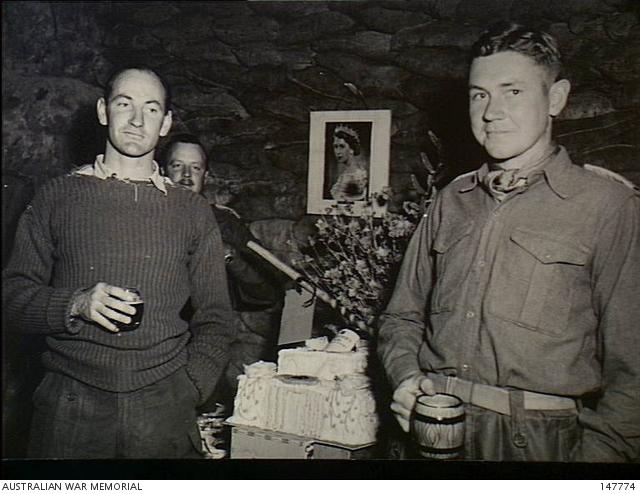Vale Brigadier Jeffrey James “JJ” Shelton DSO MC

Lieutenant Colonel Frank G. Hassett (left) celebrating his 34th birthday with Major Jeffrey J. (Jim) Shelton (right) and Major Bill Finlayson (behind).
James Shelton was born in Melbourne on the 29th of June 1926. He attended Scotch College in Melbourne, and then Bendigo High School, before going on to study engineering at Melbourne University.
Shelton entered Duntroon as a cadet in February 1944. After graduating in December 1946, he was sent to Japan to serve with the British Commonwealth Occupation Force in Japan joining the 66th Battalion. He returned to Australia two years later, having been promoted to acting captain.
He next served as adjutant to a Citizens’ Military Force battalion in Adelaide, which is where he heard about the start of the Korean War.
Shelton was sent to the reinforcement holding unit in Japan in 1951 and joined the 3rd Battalion, The Royal Australian Regiment (3RAR) as a reinforcement officer after the battle of Kapyong.
He commanded A Company during the battle of Maryang San, for which he was awarded a Military Cross for his personal bravery and leadership.
After returning to Australia in 1952, Shelton was sent to England for a two year posting with the British Army. Here he attended numerous infantry courses and was attached to a British Battalion based at Luneberg in Germany, as part of the British Army of the Rhine.
On his return to Australia, Shelton served at the School of Infantry at Singleton before being posted as adjutant to Duntroon, where he was reunited with his friend and former commanding officer, Colonel (later General Sir) Frank Hassett.
Two years later, Shelton was posted to the Defence Force Staff College at Quetta in India. It was a posting he thoroughly enjoyed.
His next posting was to Army Headquarters in Melbourne. During this posting Army HQ transitioned to Canberra. Shelton returned to 3RAR as a company commander, before being promoted to lieutenant colonel.
Another two year posting to England followed, this time as an exchange instructor at the British Army Staff College, then located at Camberley. During this period Shelton met luminaries such as Field Marshal Bernard Montgomery.
On his return to Australia at the start of 1967, Shelton was posted as commanding officer of 3RAR, then based at Woodside, South Australia. He was delighted to command the battalion with which he had already seen so much service and felt it to be the pinnacle of his service career. 3RAR deployed to Vietnam at the end of the year, and was soon on operations in Phuoc Tuy Province.
Shelton and his men took part in numerous operations in Vietnam, most notably the battles of Coral and Balmoral in May of 1968, in which the battalion experienced the most sustained combat experienced by Australian soldiers in the Vietnam War. Shelton was awarded the Distinguished Service Order for his leadership during the long month of near-constant fighting.
After returning to Australia, Shelton returned to Army HQ and was promoted to colonel. After further postings to Citizen Military Forces, regular army units, and headquarters, he was promoted to brigadier. In 1972 he was given command of the 3rd Task Force (as it was then known) in Townsville. In 1974 Shelton returned to Army Headquarters in Canberra and took up several more staff appointments.
Following his retirement from the army in 1980, he was made honorary colonel of the Australian Army Band Corps, a position he held for 14 years. Shelton also completed a degree in history and geography at the Australian National University, Canberra.
Sunday 13 May 2018 marked the 50th anniversary of the first battle of Coral. While watching the ceremony from his hospital bed, Jim Shelton, who had been unwell for some time, closed his eyes and passed away peacefully. He was 92 years old.
Shelton will be remembered by those who knew him and those who served with him as a true gentleman and a soldier’s soldier.
Vale Brigadier Jim Shelton, 29 June 1926–13 May 2018